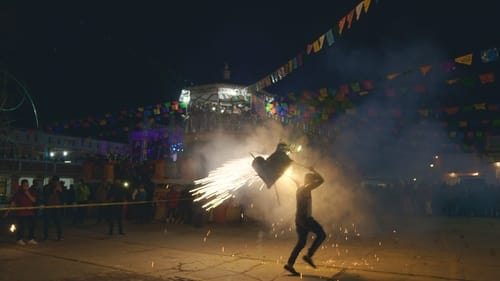Trisha Ziff
История
Director Trisha Ziff is originally from London but lives and works in Mexico City. She is a curator of contemporary photography, a filmmaker, and a Guggenheim scholar. Ziff is the producer of documentary Oaxacalifornia (US/UK), co-producer of My Mexican Shiva (Mexico), and Executive Producer of 9months 9days (Mexico). She has also worked in the North of Ireland, where she founded Camerawork Derry, a photography and film workshop in the 1980’s.

Writer
The Mejia family emigrated from Oaxaca to Fresno, California 40 years ago. Filmmaker Trisha ZIff filmed the family in 1996, and returns now to see the changes that have settled over them, and follows the family on their return to Mexico.

Producer
The Mejia family emigrated from Oaxaca to Fresno, California 40 years ago. Filmmaker Trisha ZIff filmed the family in 1996, and returns now to see the changes that have settled over them, and follows the family on their return to Mexico.

Director
The Mejia family emigrated from Oaxaca to Fresno, California 40 years ago. Filmmaker Trisha ZIff filmed the family in 1996, and returns now to see the changes that have settled over them, and follows the family on their return to Mexico.

Writer
Two countries, two restaurants, one vision. At Gabriela Cámara's acclaimed Contramar in Mexico City, the welcoming, uniformed waiters are as beloved by diners as the menu featuring fresh, local seafood caught within 24 hours. The entire staff sees themselves as part of an extended family. Meanwhile at Cala in San Francisco, Cámara hires staff from different backgrounds and cultures, including ex-felons and ex-addicts, who view the work as an important opportunity to grow as individuals. A Tale of Two Kitchens explores the ways in which a restaurant can serve as a place of both dignity and community.

Director
Two countries, two restaurants, one vision. At Gabriela Cámara's acclaimed Contramar in Mexico City, the welcoming, uniformed waiters are as beloved by diners as the menu featuring fresh, local seafood caught within 24 hours. The entire staff sees themselves as part of an extended family. Meanwhile at Cala in San Francisco, Cámara hires staff from different backgrounds and cultures, including ex-felons and ex-addicts, who view the work as an important opportunity to grow as individuals. A Tale of Two Kitchens explores the ways in which a restaurant can serve as a place of both dignity and community.

Writer
A pair of identical twins, one a photographer and the other a painter, have very little in common.

Director
A pair of identical twins, one a photographer and the other a painter, have very little in common.

Director
A film about fragility; about a man obsessed with photographing the accident who discovered that the fate of others was his way of connecting to life. When does the image of the accident become the object of desire? Following the footsteps of Metinides and the work of contemporary tabloid photographers, we discover Mexico City through a narrative of crime scenes and accidents; rubbernecking though Metinides’ Gaze.

Screenplay
A film about fragility; about a man obsessed with photographing the accident who discovered that the fate of others was his way of connecting to life. When does the image of the accident become the object of desire? Following the footsteps of Metinides and the work of contemporary tabloid photographers, we discover Mexico City through a narrative of crime scenes and accidents; rubbernecking though Metinides’ Gaze.

Screenplay
В 2007 году в Мехико были обнаружены три чемодана, в которых в общей сложности сохранились более 4500 негативов трех испанских фотографов Роберта Капы, Герды Таро и Дэвида «Чим» Сеймура. Эти неизвестные страницы истории позволили по кусочкам восстановить Испанию времен Второй Мировой войны, которую освещали военные фотографы. За каждым кадром стоит чья-то жизнь, чьи-то близкие и родные, каждая фотография — человеческая судьба, полная боли и страданий. Спустя семьдесят лет документальная лента «Мексиканский чемодан» освещает те эпизоды в мировой истории, забывать о которых никогда нельзя.

Director
В 2007 году в Мехико были обнаружены три чемодана, в которых в общей сложности сохранились более 4500 негативов трех испанских фотографов Роберта Капы, Герды Таро и Дэвида «Чим» Сеймура. Эти неизвестные страницы истории позволили по кусочкам восстановить Испанию времен Второй Мировой войны, которую освещали военные фотографы. За каждым кадром стоит чья-то жизнь, чьи-то близкие и родные, каждая фотография — человеческая судьба, полная боли и страданий. Спустя семьдесят лет документальная лента «Мексиканский чемодан» освещает те эпизоды в мировой истории, забывать о которых никогда нельзя.

Director
Examines the history and legacy of the photo Guerrillero Heroico taken by famous Cuban photographer Alberto Díaz Gutiérrez. This image has thrived for the decades since Che Guevara's death and has evolved into an iconic image, which represents a multitude of ideals. The documentary film explores the story of how the photo came to be, its adoption of multiple interpretations and meanings, as well as the commercialization of the image of Ernesto "Che" Guevara.

Producer
Sylvia Stevens' 1995 documentary introduced viewers to the Mejía family of Fresno, California, whose parents emigrated from Mexico's beautiful but impoverished southern province of Oaxaca to make a living in the U.S. Despite the family's thriving landscaping business and thoroughly assimilated children, the ties to the family's ancestral home are strong, maintained each year with a family trip back for their home village of Jaltepec's fiesta in honor of Saint Mary Magdalene.

Screenplay
Sylvia Stevens' 1995 documentary introduced viewers to the Mejía family of Fresno, California, whose parents emigrated from Mexico's beautiful but impoverished southern province of Oaxaca to make a living in the U.S. Despite the family's thriving landscaping business and thoroughly assimilated children, the ties to the family's ancestral home are strong, maintained each year with a family trip back for their home village of Jaltepec's fiesta in honor of Saint Mary Magdalene.






